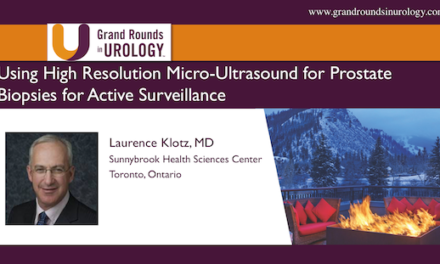Dr. Phillip J. Koo spoke at the 24th International Prostate Cancer Update on Friday, February 21, 2014 on “Advance in PET Imaging.” In his presentation, Dr. Koo discusses advances in PET imaging and what the future holds.
Presentation
Keywords
PET imaging, radiopharmaceuticals, FDG, choline, sodium fluoride
How to cite: Koo, Phillip J. “Advances in PET Imaging.” Grand Rounds in Urology. January 14, 2015. Accessed [datetotoday]. https://dev.grandroundsinurology.com/prostate-cancer-phillip-j-koo-pet-imaging/.
Transcript
Advances in PET Imaging
So a warning, there’s a lot of confusion ahead, so I’ll try to keep it clear. Disclosures—I participated in a reader study for approval of a new radiopharmaceutical in neuro-imaging for GE, and I’ll discuss another radiopharmaceutical from GE that will be used in prostate cancer.
So we’ll start off with two polling type questions first. So besides FDG, which is the glucose analogue, and sodium fluoride I have access to other PET radiopharmaceutical such as C11 choline acetate, PSMA or anything but just not FDG or sodium fluoride. So surprisingly I thought it would be even less than 27 that had access. Alright, we’ll move on to the next question. The most promising PET radiopharmaceutical in prostate cancer is FDG, choline, FACBC, methionine—I thought I included PSMA, but I guess it was eliminated. I thought I had another category, but that’s fine. Alright, choline.
Alright, so let’s move on. It is kind of the right answer I think, but we’ll see. We get a lot of mixed signals, and I think based on the question that was submitted earlier this morning there is a lot of frustration around PET radiopharmaceuticals. We hear a lot about it. We read various things. This is better than this. This is better than that. It’s really confusing. It leads to a lot of frustration, which we saw in that question and we saw from Dr. Pinto’s response as well. It’s just difficult to get these to market. So we feel lost and we feel doubtful that this will actually ever be a reality. I think what we need is a vision. It’s going to be a multidisciplinary vision, I think. It’s not going to be driven solely by radiologists. It’s going to be driven by our colleagues in urology, oncology, radiation oncology, and industry as well to really make a difference when it comes to radiopharmaceuticals. I wish I could say this was me taken on top of a mountain, but it’s not going to happen.
Alright, so what are the challenges? I think the biggest challenge, as we saw in that first polling question, is a lot of these aren’t available in the US for clinical use, routine clinical use. In Europe it’s a different story, but here in the US we really struggle with providing these nationwide. Then the other question is are these techniques really better than what we’re doing now. I think the more important question is if they are better is there a clinical benefit and is there improved outcomes, which is a very difficult question to answer and a very expensive question to answer using these novel imaging techniques.
So this is a physics cartoon, and one thing I learned is the fastest way to lose an audience is to talk about physics. So I’m not going to go over this. All I’m going to say is that PET technology is much better than any of the other nuclear technology we’ve had in the past. Dr. Pinto showed slides on indium-111. That uses a traditional gamma camera. I imagine Martin Pomper’s group is probably pushing towards a PET use for these PSMA agents.
So this is a MIP from a sodium fluoride PET CT. These are kind of the beautiful images that you get. You get remarkable detail in the bones. It spins and you just see all these different areas of uptake, and it’s kind of scary. It’s very quick to jump to the conclusion that this guy has diffuse metastatic disease, but he actually doesn’t. There’s actually—99% of the scan was normal. There was only one area that was metastatic here in the left iliac crest, and this is where you get the sensitivity. The bone imaging agent lights up here in the left iliac crest. On CT you correlate it with a tiny sclerotic focus in the bone, and then when you fuse them together you just get this really pretty image. So it sort of just makes you feel better. You see this other area of uptake here, and clearly that’s just degenerative changes in the SI joint. So we had a ton of information, a lot of noise, but we found the signal and the signal was this tiny little focus that would change the management of this patient.
So when we talk about PET radiopharmaceuticals the major ones that we’re looking at are fluorine, carbon, nitrogen, and oxygen. Yes, there are other ones—zirconium, gallium and whatnot, but really the gold standard is going to be fluorine-18. The reason is because the half-life is roughly two hours. If you could produce a compound that could be labeled with fluorine-18, you could pretty much distribute it throughout the country and throughout the world. The problem right now is the compounds that we have for prostate cancer imaging, mostly C11 choline, is carbon-11, which has a half-life of 21 minutes. Basically, that limits you to sites that have an on-site medical cyclotron, which is a very difficult program to run, which we’ve experienced at the University of Colorado.
So this is a review article from 2009, Dr. Choyke was one of the authors, that really just goes over the different stages of prostate cancer, what the current imaging techniques are and what the future holds. It’s kind of frustrating that in four years this chart really hasn’t changed. I don’t think we’ve really made much meaningful progress in these past four years, but PET really has the potential to make a role when it comes to diagnosing metastatic disease in advanced prostate cancer. When it comes to localized disease, diagnosis and whatnot, we’ve seen at this meeting that MR is really where it’s at. When you combine MR with ultrasound I think it unlocks a lot of interesting potential. PET does have the potential to do it. MR/PET, PET/MRI is another promising field, but again right now PET radiopharmaceuticals are really about diagnosing metastatic disease. This is something that Dr. Pinto talked about briefly, so I’ll skip over this.
First, we’re going to talk about state of the art imaging of the bone. I’m not going to talk too much about this because we’ve covered this, I think, over the past couple years at this meeting. The first thing that we always hear about is sodium fluoride PET CT. Basically, multiple single site studies have shown it has improved sensitivity and specificity. I think there are a lot of false positives because there’s a steep learning curve, but once it’s done correctly I think the sensitivity and specificity are hard to beat. It’s faster and more convenient for patients. There’s a robust infrastructure. Pretty much you can get this anywhere in the country anywhere in the world. You don’t have to deal with shortages, which we often deal with technetium-99. The radiation exposure if you eliminate the CT portion of it is pretty much equivalent to a regular bone scan. You can quantitate, and we’ll talk about the significance of that a little later. You can combine it with a diagnostic CT and give IV contrast.
Multiple studies continue to come out that really just show it’s better than our traditional bone scans. It again questions the use of whole body bone scans in our practice. Do I think this will replace the traditional bone scan? Maybe, maybe not. But I think there’s no doubt it should play a role in your practice. I’ve spoken with many people at this meeting who have gone back and tried sodium fluoride, and they’ve had really good results. I encourage you to speak with your local radiology group and see how you could incorporate this into your practice.
So this data comes from Evan Yu from the ACRIN trial that looked at dasatinib on bone METs measured with sodium fluoride. This was presented at ASCO in 2013 in SNM. Basically what they saw was changes in the fluoride uptake correlated with progression-free survival. So the increase in uptake on a bone scan actually meant the patient would do better. So it really led to the hypothesis that the flare phenomenon may confer better outcomes. This makes sense because we’re imaging the response in the bone. We’re not actually imaging the tumor itself. I think this is encouraging, and we’re going to hear tomorrow from Dr. Petrylak about different bone radiopharmaceuticals and what role this could play in prognosis. You know, with radium 223 and other bone agent I think there is a lot of data here that we need to sort of look at. I believe there are some clinical trials looking at that.
So just to provide an update on the NOPR, which is the National Oncologic PET Registry, which is covering these scans under their continuing evidence development program they close the program for your routine FDG scans in solid tumors but when it comes to sodium fluoride PET CT it’s still open and will likely be open at least through 2014. So if you want to get it covered through that program you should act quickly.
So we talked about how bone scans image is secondary response. What direction we really need to head in is an agent that’s going to image bone and soft tissue simultaneously and an agent that’s going to image the tumor primarily. The agent that we hear about all the time is choline, and choline can be labeled to C11 or F18. Obviously, F18 is going to be where we want to go because it has a better half-life. That being said, it’s currently under patent and it’s not available. They haven’t opened it up to the use in the US. C11 choline currently I think is only offered in a handful of institutions. The first was the Mayo Clinic.
So choline is a marker for membrane metabolism. It has high avidity for malignant prostate tissue. Useful for prostate cancer relapse. Early detection of nodal involvement in metastatic disease and bone. Even before you see osteoblastic changes, which is the key when you compare it to sodium fluoride. Meta-analysis performed – – basically showed significantly high detection rate of lymph node or just the metastases than the other standard imaging modalities, particularly in patients with lower PSA values. They go down to maybe one or so. Their recommendation based on the meta-analysis was that choline should be used as a first imaging exam with patients with biochemical recurrence and lower PSA values beginning at one. They provided this flow chart that sort of outlines what they had recommended based on this meta-analysis that was composed of multiple, I think, single site studies.
Another paper talked about recommendations of using choline in patients with fast PSA kinetics, and they recommended maybe PSA doubling times less than six months or higher than one nanogram per mL per year. The EAU guidelines in 2013 actually incorporated this into their guidelines, and they acknowledged the fact that there wasn’t robust data but they did, you know, acknowledge that the PSA values—the accuracy of PET correlated with PSA values greater than 1.5, fast doubling times less than three months, and other pathologic features. So in the end they said that, you know, you should use these studies if available and if it would impact therapy, which makes sense.
I think what throws kind of a wrench into all this is this amino acid called FACBC, and Dr. Pinto had talked briefly about it. It’s an amino acid analogue. It’s currently being licensed by GE. Preliminary results show that it was better than C11 choline, and their final results, which were published in 2013, showed that it detected metastatic disease in 20% additional patients and a 60% increase in total lesion detection. The problem with this study was it was, I think, single site, only 15 subjects but nonetheless I think it shows data that’s promising. Based on this data, ACRIN is actually developing a clinical trial looking at FACBC, which is encouraging.
So now we’re going to talk about FDG, which is something that we sort of ignore when it comes to prostate cancer imaging. The reason being is because it’s not very sensitive in prostate cancer nor is it very specific. I’m going to sort of walk you through a case which sort of demonstrates this. This is a 63-year-old man. We were given history of castration-resistant prostate cancer. We were given history of rising PSA. We weren’t given exact numbers. The patient also had a history of colon cancer. So we got an FDG PET CT. You see these retroperitoneal nodes that are very FDG avid. These had gotten worse over the prior six—compared to the exam six months ago. So it made you think oh what was going on there.
Then there were these new nodes in the mediastinum and the neck that were lighting up. So it really made us question was this prostate cancer getting worse. Was this colon cancer? You don’t really know. You know, you’re given very little history to begin with, so it’s hard to put all the pieces together. So the first question was are these retroperitoneal nodes metastatic colon cancer or metastatic prostate cancer. I think the answer is probably we’re not sure. The cervical nodes, again, we’re not sure. So we went digging through the electronic medical record, and we found that this guy had CRPC and rising PSA. His colon cancer was T3, N0, M0, and he had normal CEA that was not rising. So based on that information we felt pretty sure that the retroperitoneal nodes were prostate cancer, but that still made us question about the cervical nodes. We agree that it can involve cervical nodes, but also we found out that the patient received sipuleucel-T two days prior to the PET CT. That made us lean towards those nodes up there being reactive due to the injection of sipuleucel-T, which kind of tells us that it’s working, though that’s never been proven.
Alright, so FDG PET CT, glucose uptake really depends on tumor differentiation. There’s low uptake in well-differentiated tumors. There’s high uptake in aggressive tumors. When you’re dealing with castrate resistant prostate cancer you typically have a lot of FDG uptake because it’s more aggressive. CMS acknowledges the benefit of FDG in prostate cancer to determine effective treatment. Based on the NOPR findings in prostate cancer, in 40% of instances physicians change their management plans based on the FDG PET scans. So they felt like it was reasonable and necessary if you wanted to use it for subsequent treatment strategy, but in their final decision they left it up to the local Medicare contractors to prove or not approve FDG PET scans.
So this is some interesting research that we’re doing in our campus at the University of Colorado, and this comes from the work of Dr. Schlaepfer in the Department of Pharmacology. In these, I believe they were mice models, she transferred prostate cancer cells into the subcutaneous tissues. At baseline you notice that you really can’t see the cells, but when these mice were treated with etomoxir, which is a fatty acid oxidation inhibitor, you could actually see them now in that you could see the prostate cancer cells. This just shows the increase in activity using normal uptake values in the etomoxir treated mice versus the vehicle mice. The problem with etomoxir is it isn’t FDA approved, so we wanted an FDA proved drug to simulate this. She used ranolazine, which is FDA approved for the treatment of angina and an increase in glucose uptake. She saw a similar effect using ranolazine in those prostate cancer cells.
This comes from subject match prostate derived primary cells from surgery I think from doctors Crawford and Maroni, which were Gleason 7 prostate cancer cells and then in vitro they were exposed to etomoxir versus vehicle. At 24 hours there was a significant increase in glucose uptake in the cancer cells that were exposed to etomoxir. Interestingly, at 48 hours the number of viable cells went significantly down in those patients exposed to etomoxir, which makes you wonder if there is a therapeutic effect to changing the metabolism of these prostate cancer cells.
So this got a lot of people excited, and Dr. Glode put together a team to really tackle this idea. He brought together myself, Elaine Lam, and a whole group of people to work together to sort of pursue this further. He also provided money, which we’re always grateful for, to get this started. So it’s a team approach from urology. We have doctors Crawford and Maroni from urologic oncology, doctors Glode and Lam and Dr. Lucia from pathology to really—and obviously Dr. Schlaepfer from pharmacology. So basically what we’re doing is we’re doing a baseline FDG PET scan. We’re exposing them to ranolazine for five days and then we’re doing a follow-up PET scan to see what type of signal we get after they’re exposed to ranolazine. So we have two arms—those with localized disease who are candidates for surgery and those with advanced disease. Those with localized disease are going to go on to surgery, and then we’ll do whole mount slides and see what we get with that evaluation. Our first, I think, subject is scheduled for next Friday, so we’re excited about that.
So what does the future hold? I still think we’re not sure. I think choline is definitely promising. ACBC I think throws a wrench into all this. The fact that they have a clinical trial that’ll open I think is very promising. PSMA also is very promising, but I think in the end the answer is really going to be clinical trials. That’s what we need to focus on, and radiology is a little late to the game but hopefully we’ll get this started. I put this in twice I guess just to emphasize that we really need clinical trials. Alright, so, you know, in radiology we’re always trying to, you know, deal with these fancy tools and whatnot. That’s great, but I think in today’s society with costs being a very major factor of what we do we need to really think twice. That’s kind of why I think this project using FDG could, you know, have some value—because it’s cheap. A dose of FDG will cost you $120. A dose of some of these new radio-pharmaceuticals cost thousands.
So the RADAR group, which was chaired by Dr. Petrylak and Dr. Crawford last year met and published a paper that’s available online that talks about diagnosing metastatic disease, early identification of metastatic disease. Basically, in the end we’re still going to rely on our traditional bone scans and CT as the imaging modalities of choice. I think sodium fluoride and some of these other modalities such as MR can be incorporated into your practice at your discretion, but it’s clear that, you know, we need more data to look at these newer imaging modalities because we have more therapies in prostate cancer. I think the imaging will complement these therapies and allow for more elegant refined procedures. That’s it. Thank you.
References
Castellucci P, Picchio M. 11C-choline PET/CT and PSA kinetics. Eur J Nucl Med Mol Imaging. 2013 Jul;40 Suppl 1:S36-40. http://www.ncbi.nlm.nih.gov/pubmed/23579864
Jadvar H, Pinski J, Quinn D, Ye W, et al. Concordance among FDG PET, CT and bone scan in men with metastatic prostate cancer. Proc SNM 55th Ann Meeting; New Orleans, LA. 2008.
Kelloff GJ, Choyke P, Coffey DS, et al. Challenges in clinical prostate cancer: role of imaging. AJR Am J Roentgenol. 2009 Jun;192(6):1455-70. http://www.ncbi.nlm.nih.gov/pubmed/19457806
Nanni C, Schiavina R, Boschi S, et al. Comparison of 18F-FACBC and 11C-choline PET/CT in patients with radically treated prostate cancer and biochemical relapse: preliminary results. Eur J Nucl Med Mol Imaging. 2013 Jul;40 Suppl 1:S11-7. http://www.ncbi.nlm.nih.gov/pubmed/23591953
Osborne JR, Green DA, Spratt DE, et al. A prospective pilot study of (89)Zr-J591/prostate specific membrane antigen positron emission tomography in men with localized prostate cancer undergoing radical prostatectomy. J Urol. 2014 May;191(5):1439-45. http://www.ncbi.nlm.nih.gov/pubmed/24135437
von Eyben FE, Kairemo K.Meta-analysis of (11)C-choline and (18)F-choline PET/CT for management of patients with prostate cancer. Nucl Med Commun. 2014 Mar;35(3):221-30. http://www.ncbi.nlm.nih.gov/pubmed/24240194
ABOUT THE AUTHOR
Phillip J. Koo, MD, is the Division Chief of Diagnostic Imaging and Northwest Region Oncology Physician Executive at the Banner MD Anderson Cancer Center in Phoenix, Arizona. Prior to this, he was Chief of Nuclear Medicine and Associate Professor of Radiology at the University of Colorado School of Medicine. Dr. Koo completed his transitional internship at the University of Pennsylvania Medical Center-Presbyterian, his radiology residency at Pennsylvania Hospital of the University of Pennsylvania Health System, and his fellowship at the Harvard Medical School Joint Program in Nuclear Medicine. He is a diplomate of both the American Board of Radiology and the American Board of Nuclear Medicine. Dr. Koo is an active member of multiple societies and has served as the Chair of Nuclear Medicine for the RSNA Scientific Program Committee, Chair of the Quality and Evidence Committee for the Society of Nuclear Medicine and Molecular Imaging (SNMMI), and Chair of the Prostate Cancer Working Group at the SNMMI. Dr. Koo has published on various topics related to radiology and nuclear medicine in multiple journals such as Radiology, Radiographics, the European Journal of Nuclear Medicine and Molecular Imaging, Urology, and the Journal of the American College of Radiology.





